Matcha
10 Best Insights: Matcha Vs Coffee Antioxidants

Welcome to our exploration of the 10 best insights on the matcha vs coffee antioxidants debate!
In this article, we will delve into the world of antioxidants and compare the antioxidant powerhouses of matcha and coffee.
As enthusiasts seeking mastery in our understanding of these beverages, we aim to provide you with valuable information to make informed choices.
Prepare to uncover the unmatched antioxidant levels of matcha and explore the surprising contender that coffee proves to be.

Through a comprehensive nutritional breakdown, we will compare the two and shed light on their respective health benefits.
Join us on this journey as we evaluate the effects of matcha and coffee on our hearts and cognitive functions.
Let’s find the perfect balance between these two healthful elixirs!
Key Takeaways
- Matcha has a higher concentration of antioxidants, specifically catechins, compared to coffee.
- Matcha’s vibrant green color is due to its high chlorophyll content, which also has antioxidant properties.
- Matcha offers a sustained and calm energy boost due to its unique combination of caffeine and L-theanine.
- Coffee antioxidants, such as chlorogenic acid, enhance brain function and protect against diseases.
Matcha Vs Coffee: Antioxidant Powerhouse
We believe that matcha and coffee are both antioxidant powerhouses. When it comes to taste, matcha and coffee offer distinct flavor profiles. Matcha has a rich, earthy taste with a slight bitterness. It’s often described as vegetal or grassy, with a smooth and creamy texture. On the other hand, coffee has a bold and robust flavor, with varying levels of acidity and bitterness depending on the roast and brewing method.

In terms of preparation methods, matcha and coffee require different techniques. Matcha is traditionally prepared by whisking powdered tea with hot water until frothy. This process allows you to fully experience the flavor and aroma of the tea. Coffee, on the other hand, can be brewed in various ways such as drip brewing, French press, or espresso. Each method brings out different nuances in the coffee beans, resulting in diverse taste profiles.
Whether you prefer the rich and earthy taste of matcha or the bold and robust flavor of coffee, both beverages offer an abundance of antioxidants that can contribute to a healthy lifestyle.
Understanding Antioxidants: The Basics
Antioxidants are substances that help protect our bodies from damage caused by harmful molecules called free radicals. They play a crucial role in maintaining our overall health by neutralizing these free radicals and preventing oxidative stress.
Antioxidants can be found in various foods and beverages, such as fruits, vegetables, and even coffee and matcha.

Understanding the basics of antioxidants can help us make informed choices about our diet and lifestyle to support our overall well-being.
Benefits of Antioxidants
In our exploration of the benefits of antioxidants, let’s delve into the basics and gain a clear understanding of their power. Antioxidants play a crucial role in our overall health and well-being. Here are four key benefits of antioxidants:
- Protection against oxidative stress: Antioxidants help neutralize harmful free radicals in our bodies, preventing damage to cells and reducing the risk of chronic diseases.
- Anti-aging effects: Antioxidants in skincare products can help combat the signs of aging by protecting the skin from environmental damage, reducing wrinkles, and promoting a youthful appearance.
- Food preservation: Antioxidants are used in food preservation to prevent spoilage and extend the shelf life of products. They inhibit the oxidation process, maintaining the freshness and quality of food items.
- Immune system support: Antioxidants boost our immune system by reducing inflammation and supporting the body’s natural defense mechanisms, helping to fight off infections and diseases.
Antioxidants in Everyday Life
One way to incorporate antioxidants into our daily lives is by consuming foods and beverages that are rich in these powerful compounds. Antioxidants play a crucial role in protecting our cells from damage caused by free radicals, which are unstable molecules that can lead to oxidative stress and chronic diseases.
Luckily, there are plenty of everyday antioxidants that can easily be included in our diets. Fruits and vegetables like berries, leafy greens, and tomatoes are excellent sources of antioxidants such as vitamin C and beta-carotene. Other antioxidant-rich foods include nuts, seeds, and whole grains. Green tea, cocoa, and even a small amount of dark chocolate can also provide a healthy dose of antioxidants.
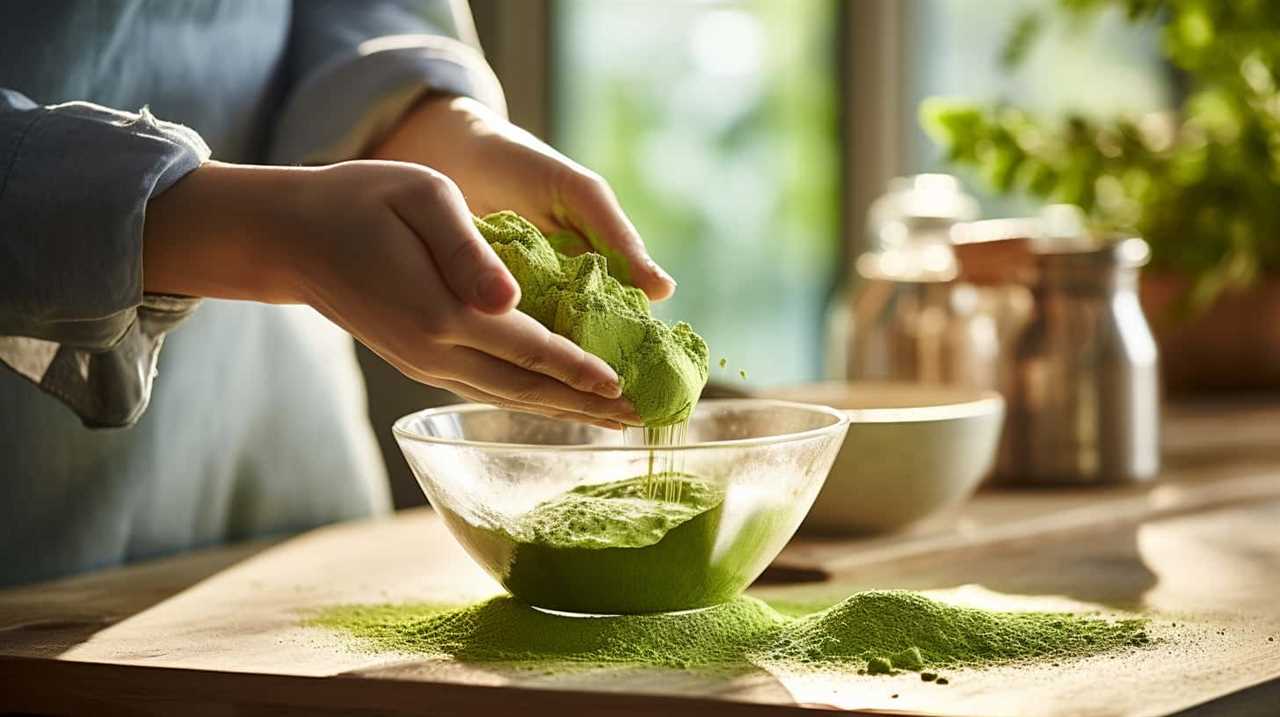
Matcha Antioxidant Levels: Unmatched
When it comes to antioxidant content, matcha leaves other beverages in the dust.
Matcha is packed with catechins, a type of antioxidant that helps to neutralize free radicals and protect against cell damage.
Studies have shown that matcha has significantly higher levels of catechins compared to coffee, making it a superior choice for those seeking antioxidant benefits.
Superior Antioxidant Content
Matcha’s unmatched antioxidant levels make it a superior choice in terms of antioxidant content. Here are four reasons why matcha is one of the most superior antioxidant sources:
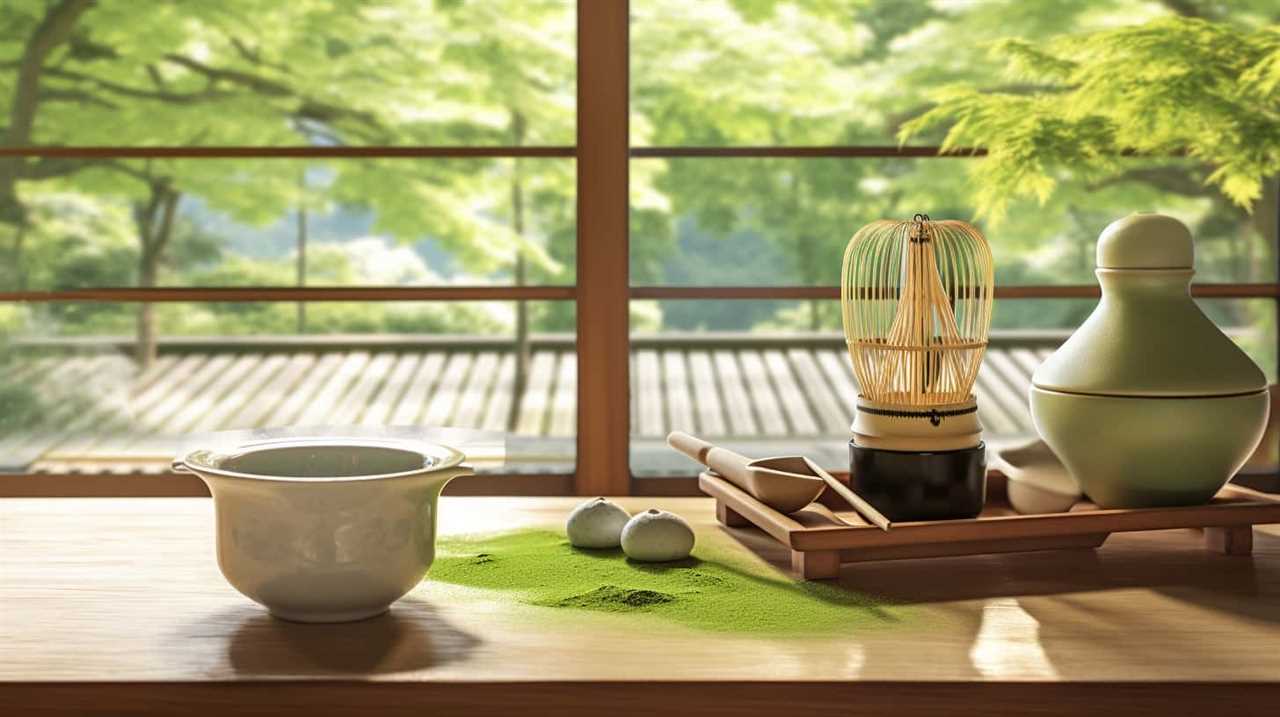
- High levels of catechins: Matcha contains a type of antioxidant called catechins, specifically epigallocatechin gallate (EGCG), which has been shown to have potent antioxidant effects.
- Abundance of chlorophyll: Matcha’s vibrant green color is due to its high chlorophyll content. Chlorophyll has been found to have antioxidant properties and can help protect against oxidative stress.
- Greater concentration of antioxidants: Compared to other antioxidant-rich beverages like green tea or coffee, matcha contains a higher concentration of antioxidants per serving, making it a more efficient source of these beneficial compounds.
- Slow release of antioxidants: Matcha is prepared by whisking the powdered tea leaves into hot water, which allows for a slow release of antioxidants. This slow release ensures a sustained antioxidant effect in the body.
With its unparalleled antioxidant levels, matcha is an excellent choice for individuals seeking to maximize their antioxidant intake and promote overall health and well-being.
Matcha Vs Coffee Benefits
Let’s delve into the benefits of matcha compared to coffee, with a focus on the unmatched levels of antioxidants found in matcha.
When it comes to energy levels, matcha and coffee offer different experiences. Coffee is known for its stimulating effects due to its high caffeine content, providing a quick burst of energy. On the other hand, matcha contains a unique combination of caffeine and L-theanine, an amino acid that promotes a sustained and calm energy boost without the crash often associated with coffee.
As for metabolism, matcha has been shown to increase thermogenesis, which helps the body burn calories more efficiently. Coffee, on the other hand, has a mild impact on metabolism.
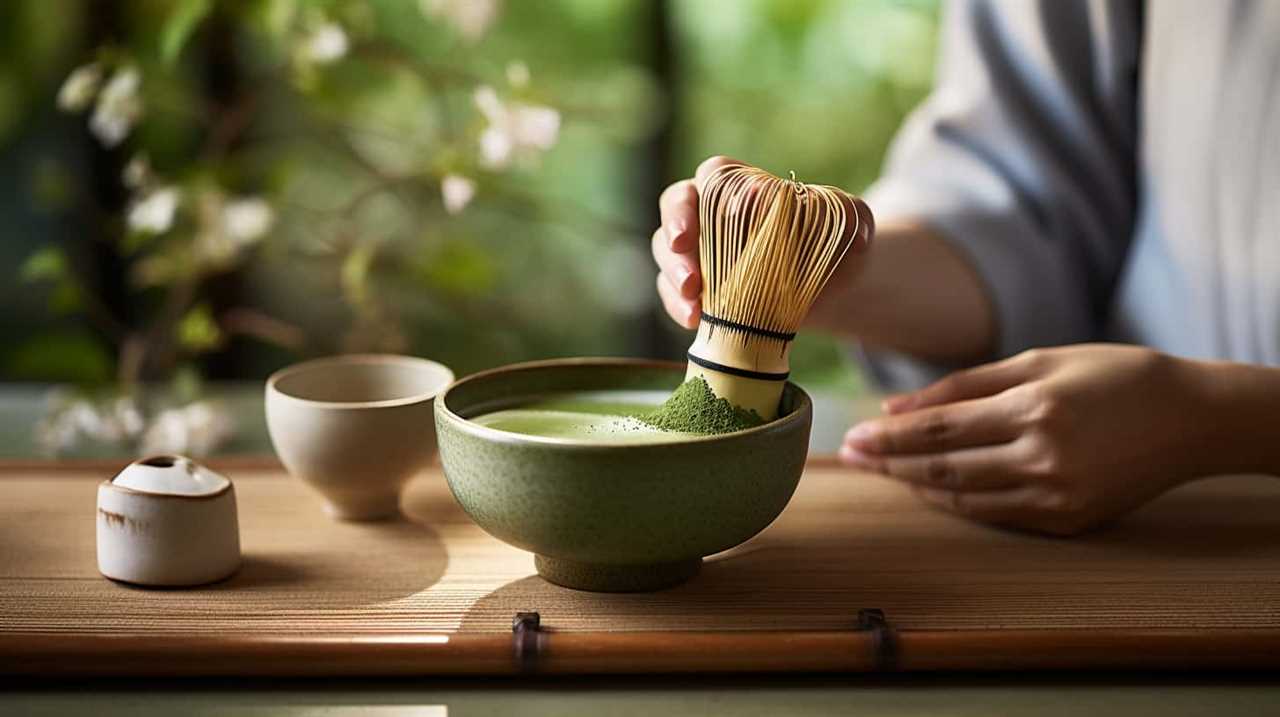
Coffee Antioxidants: A Surprising Contender
We were surprised to discover that coffee antioxidants offer a strong competition to matcha. While matcha has long been praised for its high antioxidant content, coffee also contains a significant amount of antioxidants that provide numerous health benefits.
Here are four reasons why coffee antioxidants are a surprising contender:
- Improved cognitive function: Coffee antioxidants, such as chlorogenic acid, have been shown to enhance brain function and improve memory and focus.
- Reduced risk of chronic diseases: Studies have found that coffee antioxidants can help protect against diseases like Parkinson’s, Alzheimer’s, and certain types of cancer.
- Cardiovascular health: The antioxidants in coffee have been linked to a lower risk of heart disease and stroke.
- Liver protection: Coffee antioxidants, such as caffeine and chlorogenic acid, have been found to have a protective effect on the liver, reducing the risk of liver disease.
Comparing Matcha and Coffee: Nutritional Breakdown
Now let’s take a closer look at the nutritional breakdown of matcha and coffee.
First, we’ll compare their antioxidant levels, which play a crucial role in protecting the body against oxidative stress.
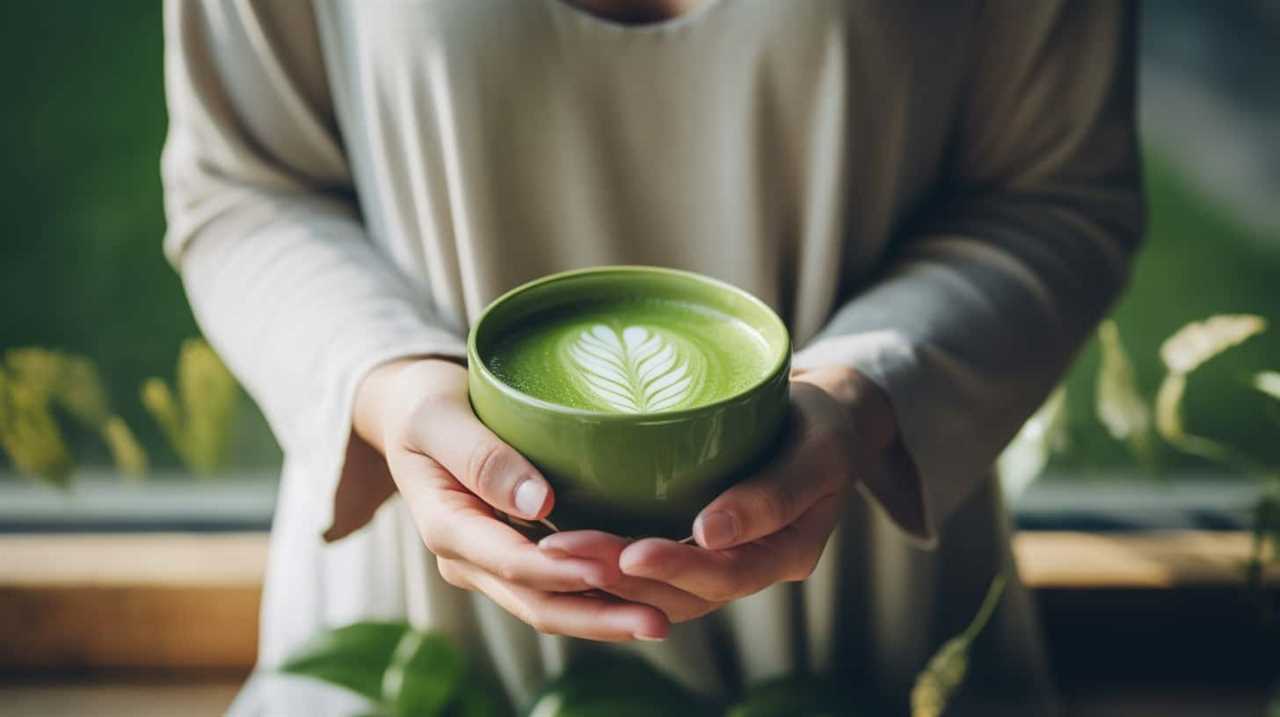
Next, we’ll provide an overview of the health benefits associated with both matcha and coffee, highlighting their unique properties.
Lastly, we’ll analyze the caffeine content of these beverages, as it can significantly impact our energy levels and overall well-being.
Antioxidant Levels Compared
While comparing the nutritional breakdown of matcha and coffee, it’s important to analyze the levels of antioxidants in each. Antioxidants are compounds that help protect the body from damage caused by harmful molecules called free radicals.
Here is a comparison of the antioxidant levels in matcha and coffee:
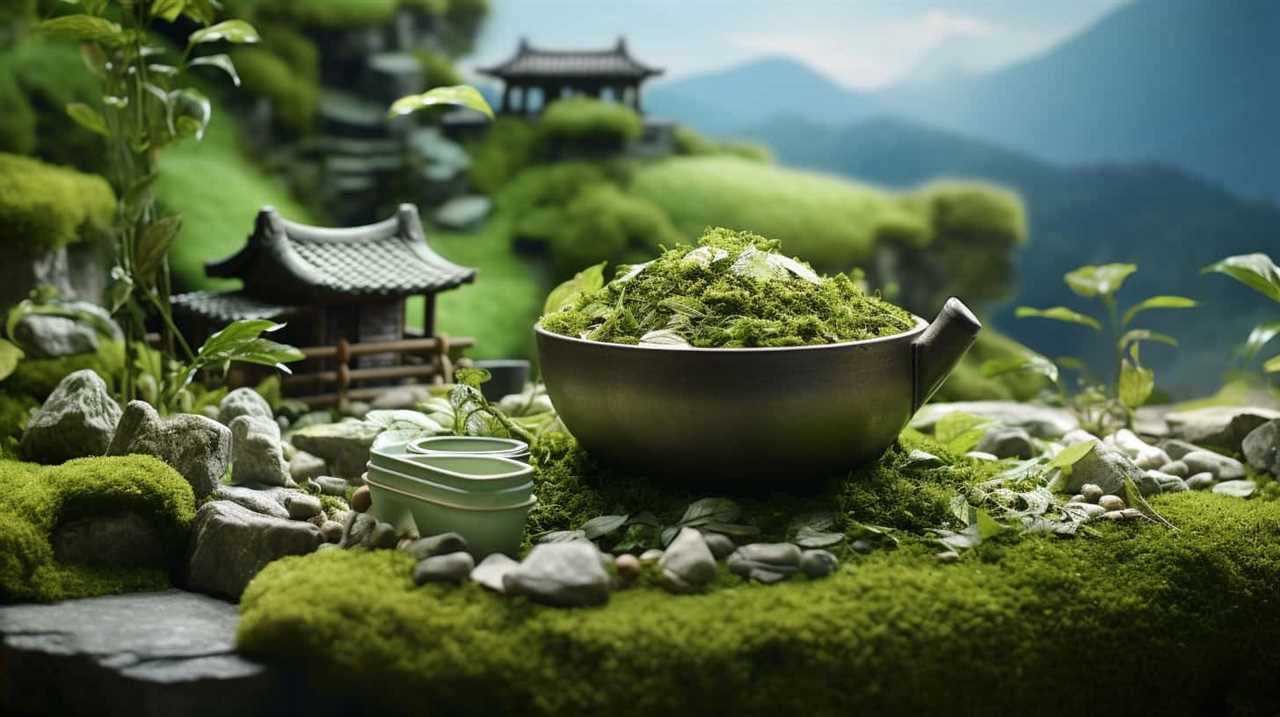
- Matcha: Matcha is known for its high antioxidant content, particularly a type of antioxidant called catechins. Catechins have been linked to various health benefits, including reduced risk of chronic diseases.
- Coffee: Coffee also contains antioxidants, such as chlorogenic acid and caffeic acid. These antioxidants have been associated with anti-inflammatory and neuroprotective effects.
- Quantity: Matcha generally contains higher levels of antioxidants compared to coffee. The preparation and extraction methods of matcha contribute to its concentrated antioxidant content.
- Health implications: Consuming foods and beverages rich in antioxidants, like matcha and coffee, may help reduce oxidative stress and lower the risk of certain diseases, such as heart disease and cancer.
Understanding the antioxidant levels in matcha and coffee can help individuals make informed choices about their dietary preferences and potential health benefits.
Health Benefits Overview
Continuing the comparison of matcha and coffee, let’s now explore the health benefits and nutritional breakdown of these two beverages.
Both matcha and coffee have their own unique set of health benefits, making them popular choices among individuals seeking antioxidant-rich foods.
Matcha is known for its high concentration of antioxidants, particularly catechins, which have been linked to various health benefits such as reducing the risk of chronic diseases and promoting heart health. Additionally, matcha contains L-theanine, an amino acid that’s believed to promote relaxation and improve mental clarity.

On the other hand, coffee is a great source of antioxidants called polyphenols, which have been associated with reducing inflammation and protecting against certain diseases. Coffee also contains caffeine, which can provide a boost of energy and improve focus.
When it comes to nutritional breakdown, matcha is lower in calories and contains more vitamins and minerals compared to coffee. However, coffee contains more caffeine, which can be beneficial for those looking for a quick energy boost.
Caffeine Content Analysis
Let’s delve into the caffeine content analysis of matcha and coffee, comparing their nutritional breakdown. Caffeine is a natural stimulant found in both matcha and coffee, and understanding its content can help us make informed choices about our daily caffeine intake.
Here’s a breakdown of the caffeine content in 8 ounces of each beverage:

- Matcha: On average, a cup of matcha contains around 30 milligrams of caffeine. This amount is lower compared to coffee, making matcha a great alternative for those looking for a milder energy boost.
- Coffee: A cup of brewed coffee typically contains about 95 milligrams of caffeine. However, the exact amount can vary depending on the brewing method and type of coffee beans used.
- Health benefits of caffeine: Both matcha and coffee provide potential health benefits due to their caffeine content. Caffeine has been linked to improved focus, increased alertness, and enhanced physical performance.
- Moderation is key: While caffeine can offer health benefits, it’s important to consume it in moderation. Too much caffeine can lead to side effects like jitters, increased heart rate, and disrupted sleep patterns.
Health Benefits of Matcha: Beyond Antioxidants
Exploring the numerous health benefits of matcha, we delve beyond antioxidants to discover its wider range of advantages.
Matcha has gained popularity for its potential role in weight loss. It contains a compound called EGCG (epigallocatechin gallate), which has been shown to enhance metabolism and increase fat oxidation. Studies have also suggested that matcha can help reduce body weight and body mass index (BMI).
Additionally, matcha has been found to have a positive impact on the immune system. It’s rich in catechins, a type of antioxidant that has been shown to boost immune function and protect against infections.
Matcha’s combination of weight loss potential and immune-boosting properties makes it a valuable addition to a healthy lifestyle.

Coffee’s Health Benefits: Not Just for Wakefulness
In the realm of health benefits, coffee offers more than just a morning pick-me-up. Here are four ways that coffee can contribute to your overall well-being:
- Reduced risk of chronic diseases: Studies have shown that moderate coffee consumption is associated with a lower risk of diseases such as type 2 diabetes, Parkinson’s disease, and certain types of cancer.
- Improved cognitive function: Coffee has been found to enhance mental alertness, memory, and concentration. The caffeine in coffee acts as a stimulant to the central nervous system, boosting brain function.
- Protection against liver disease: Research suggests that coffee consumption may help reduce the risk of liver diseases, including cirrhosis and liver cancer. The antioxidants and other compounds in coffee have been shown to have protective effects on the liver.
- Longer lifespan: Several studies have found a link between coffee consumption and increased longevity. Moderate coffee intake has been associated with a lower risk of death from various causes, including heart disease and stroke.
Matcha Vs Coffee: Which Is Better for Your Heart
Comparing the antioxidant content of matcha and coffee reveals which is more beneficial for heart health.
When it comes to the impact on blood pressure, studies have shown that both matcha and coffee can have positive effects. Matcha contains catechins, a type of antioxidant that has been associated with lower blood pressure levels. Coffee, on the other hand, contains chlorogenic acids, which have also been linked to reduced blood pressure.
As for the effects on cholesterol levels, matcha has been found to improve both LDL (bad) cholesterol and HDL (good) cholesterol levels. Coffee, on the other hand, has been shown to have a neutral effect on cholesterol levels.
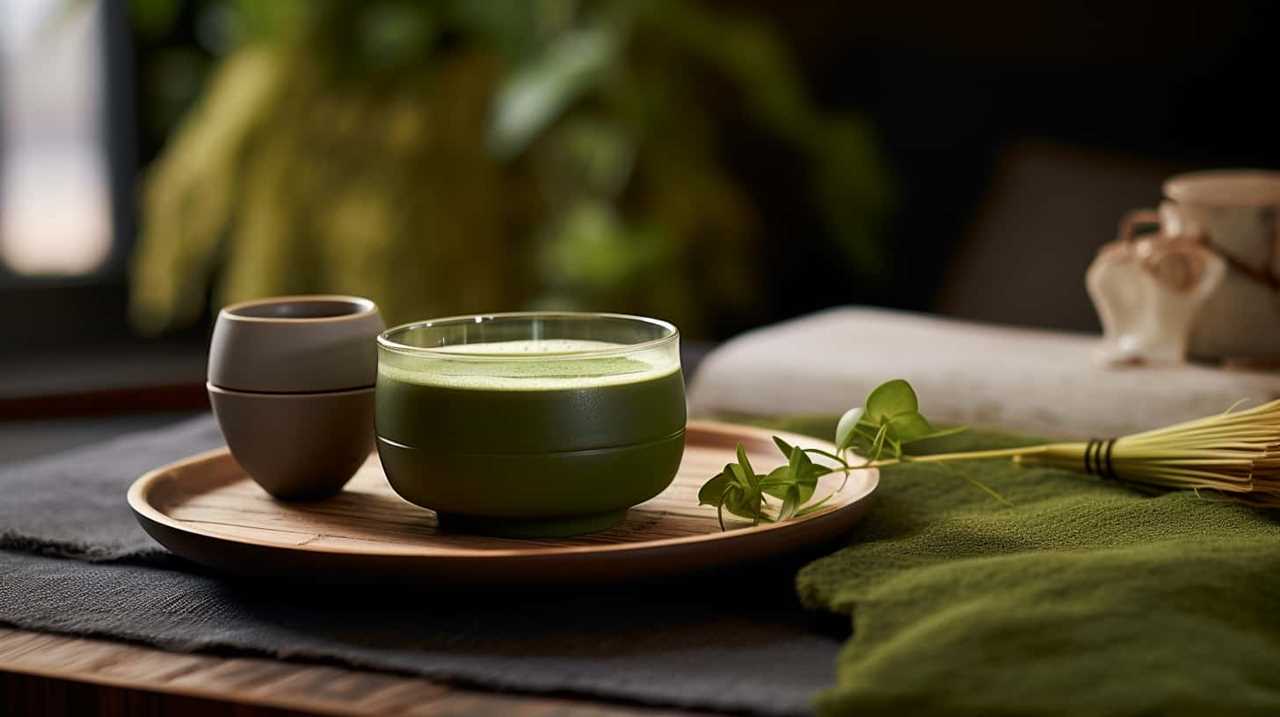
Mental Boost: Matcha and Coffee’s Cognitive Effects
To understand the cognitive effects of matcha and coffee, let’s delve into their ability to enhance mental function. Both matcha and coffee have been shown to impact focus and concentration, but in different ways. Here are four key points to consider:
- Matcha contains an amino acid called L-theanine, which promotes a state of calm alertness. This can aid in improving focus and concentration without the jittery side effects commonly associated with coffee.
- Coffee, on the other hand, contains caffeine, which acts as a stimulant. It can increase alertness and improve cognitive performance, including attention and concentration.
- Matcha has also been found to have positive effects on mood. The combination of L-theanine and caffeine in matcha can promote feelings of relaxation and reduce stress levels.
- Coffee, when consumed in moderation, can have similar mood-enhancing effects. However, excessive consumption or sensitivity to caffeine may lead to increased anxiety and stress.
Matcha and Coffee: A Healthy Balance
For a balanced and healthy approach, we can incorporate both matcha and coffee into our daily routine.
Both matcha and coffee offer unique benefits that contribute to a healthy lifestyle.
Matcha contains antioxidants called catechins, which have been shown to have various health benefits, including weight management. Studies have found that catechins in matcha can help increase metabolism and fat oxidation, potentially aiding in weight loss.

On the other hand, coffee contains caffeine, which can also have an impact on weight management. Caffeine has been shown to increase metabolism and enhance fat burning. However, it’s important to note that excessive caffeine consumption can have negative effects on health.
Therefore, it’s crucial to consume both matcha and coffee in moderation as part of a balanced diet and active lifestyle.
Frequently Asked Questions
Can Consuming Matcha or Coffee Help Prevent Chronic Diseases?
Consuming matcha or coffee can help prevent chronic diseases. Matcha and coffee both contain antioxidants, but matcha has more potent antioxidants. Antioxidants play a crucial role in preventing chronic diseases by reducing oxidative stress and inflammation in the body.
How Do the Antioxidant Levels in Matcha and Coffee Compare to Other Antioxidant-Rich Foods?
In terms of their antioxidant content, matcha and coffee can be compared to other antioxidant-rich foods. It is important to understand how the antioxidant levels in matcha and coffee stack up against these other foods.
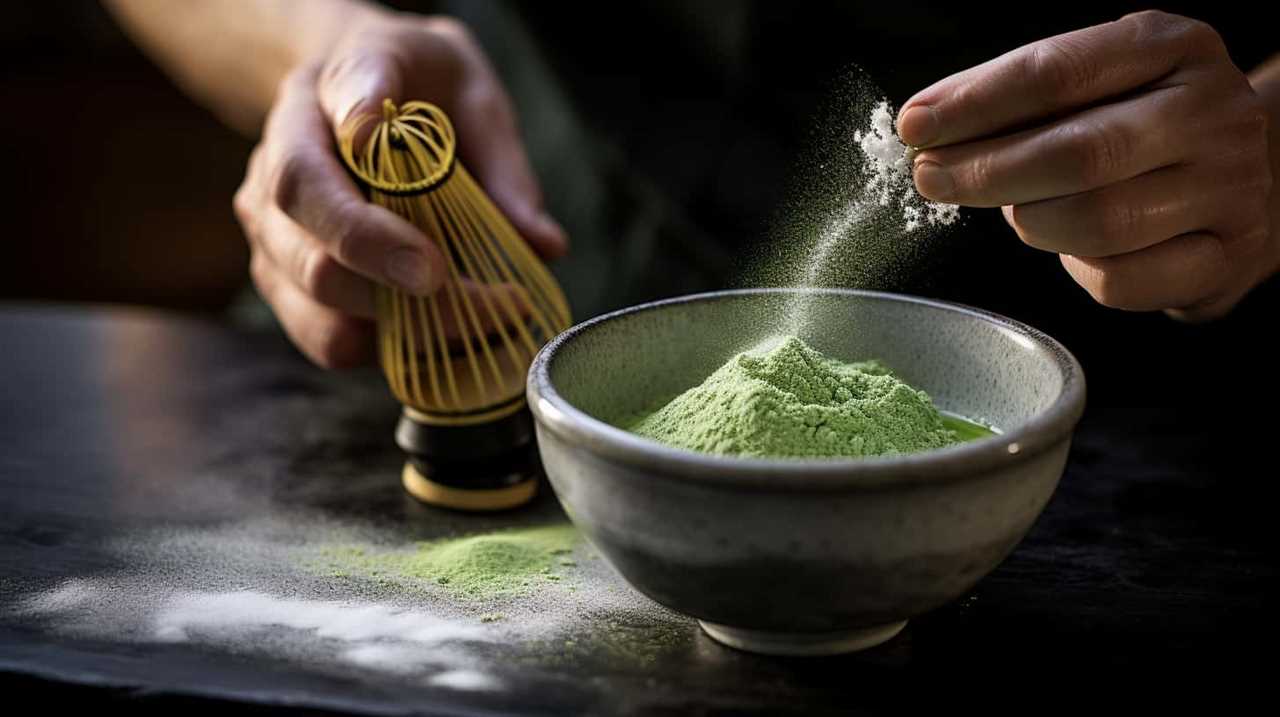
Are There Any Potential Side Effects or Risks Associated With Consuming Matcha or Coffee?
There can be potential risks and side effects associated with the consumption of matcha or coffee. It’s important to be aware of these and consume in moderation to minimize any negative effects on our health.
Can the Antioxidant Benefits of Matcha and Coffee Be Obtained Through Other Food Sources or Supplements?
Yes, the antioxidant benefits of matcha and coffee can be obtained through other food sources or supplements. For example, consuming berries or taking a green tea extract supplement can provide similar antioxidant absorption.
Are the Health Benefits of Matcha and Coffee Affected by the Way They Are Prepared or Consumed (E.G., Brewed, Powdered, Mixed With Other Ingredients)?
Brewing methods impact antioxidant levels in matcha and coffee. The role of other ingredients in preparations can also affect health benefits. It is important to consider these factors when choosing how to consume matcha and coffee.
Conclusion
In the battle of antioxidants, matcha reigns supreme with its unmatched levels. But don’t count out coffee just yet! It may surprise you as a formidable contender.

Both matcha and coffee have unique nutritional profiles and health benefits. So why not enjoy a healthy balance of both? Just like a harmonious blend of flavors, embracing the goodness of both matcha and coffee can provide a well-rounded boost for your mind, body, and heart.
Justin is a seasoned author, coffee and tea enthusiast, and an essential member of the Cappuccino Oracle team. With a keen appreciation for the complexities of coffee, coffee alternatives, and tea, Justin has dedicated his professional career to exploring these realms and sharing his insights with readers worldwide.
Justin’s immersion in the world of coffee, coffee alternatives, and tea began at a young age, kindling a passion that extended beyond mere consumption. This love for these beverages led him to combine his talent for writing with his devotion to coffee and tea, bringing him to Cappuccino Oracle as a dedicated author.
Matcha
Unveiling The Mysteries Of Matcha: Insights On Its Origins, Production, And Quality

Have you ever been curious about the mysteries behind the rich and natural flavors of matcha? If so, get ready to join me on an adventure as we uncover the secrets of matcha, delving into its origins, production, and quality.
As a lover of all things tea, I have delved deep into the world of matcha, immersing myself in its rich history and intricate production process. From the shade-grown tea leaves to the meticulous grinding technique, every step is a labor of love that culminates in the velvety smooth powder we know as matcha.
Join me as we unravel the secrets behind this ancient Japanese tradition and discover why quality is key when indulging in this verdant elixir. We’ll explore the nuances of flavor, the importance of sourcing, and even delve into the fascinating world of other tea varieties.
So grab a cup, sit back, and let’s dive into the captivating world of matcha.
Key Takeaways
- Matcha tea is made from powdered green tea leaves and has a long and labor-intensive production process.
- Premium matcha is made from the first harvest in early spring, using the top 3 sprouts of the tea plant and ground tencha leaves.
- Cheaper matchas may skip some steps in the production process and are more suitable for matcha lattes.
- High-quality matcha is recommended for sparing consumption, as it has a smoother flavor and more health benefits compared to cheaper matchas.
What is matcha?
I’ve learned that matcha is a powdered green tea made from special tea leaves that are shaded before harvest, and it has a long and labor-intensive production process.
There are different types of matcha available, but the premium matcha is made from the first harvest in early spring, using only the top 3 sprouts of the tea plant. The leaves are then steamed, dried, and have their stems removed before being ground into a fine powder using a specialized mill made of granite.
It’s important to note that high-quality matcha is recommended for sparing consumption, as it has a complex production process that results in a smooth flavor. Matcha also offers various health benefits, such as being rich in antioxidants, boosting metabolism, and improving mental alertness.
Production process
The matcha production process involves shading the tea leaves before harvest and selecting the top three sprouts of the tea plant for premium matcha. Shading is a technique used to enhance the flavor and quality of the tea leaves. By covering the tea plants with shade, the leaves produce more chlorophyll and amino acids, resulting in a vibrant green color and a rich, umami taste.
After the shading period, only the top three sprouts of the tea plant are carefully handpicked for premium matcha. These selected leaves, known as tencha leaves, are then steamed, dried, and have their stems removed.
Finally, the tencha leaves are ground into a fine powder using a specialized granite mill. This process results in the smooth and concentrated matcha powder that we enjoy.
Quality and consumption
Let me tell you, indulging in high-quality matcha is like sipping a vibrant green elixir that awakens your taste buds and nourishes your body with its rich flavor and numerous health benefits. Matcha’s health benefits are truly remarkable. Packed with antioxidants, vitamins, and minerals, matcha is known to boost metabolism, enhance focus and concentration, and strengthen the immune system.
But not all matcha is created equal. Different grades of matcha exist, ranging from ceremonial grade to culinary grade. Ceremonial grade matcha is made from the highest quality tencha leaves and has a smooth, vibrant green color and a delicate, umami flavor. It is best enjoyed on its own, whisked with hot water.
On the other hand, culinary grade matcha is more affordable and is suitable for making matcha lattes, smoothies, and baked goods. Although it may have a slightly bitter taste and a duller color, it still provides health benefits.
So, whether you choose to indulge in high-quality ceremonial grade matcha or opt for the more affordable culinary grade, incorporating matcha into your routine is a delicious way to reap its health benefits.
Frequently Asked Questions
What are some popular ways to enjoy matcha besides drinking it as tea?
Besides drinking matcha as tea, some popular ways to enjoy it include indulging in matcha desserts like matcha ice cream, matcha cake, and matcha cookies. Additionally, matcha smoothies are a refreshing and healthy option.
Are there any specific health benefits associated with consuming matcha?
I’m no expert, but matcha is said to have potential health benefits. Some claim it can aid in weight loss due to its high antioxidant content and metabolism-boosting properties. However, more research is needed to confirm these claims.
How does the quality of matcha affect its flavor and overall experience?
The quality of matcha directly affects its flavor and overall experience. Higher quality matcha, made from carefully selected leaves and processed with precision, offers a smoother and more vibrant flavor, while lower quality matcha may have a less appealing taste and color.
Can matcha be used in cooking or baking?
"Where there’s matcha, there’s a way! Matcha can be used in a variety of cooking and baking recipes, adding a vibrant green color and a unique earthy flavor to dishes like matcha desserts."
Are there any specific tips or techniques for properly preparing matcha tea at home?
To properly prepare matcha tea at home, start by sifting the matcha powder to remove any clumps. Then, choose water at around 175°F to 180°F for the best flavor. Gradually add water to the matcha and whisk in a "W" or "M" motion until frothy. Enjoy!
Conclusion
In conclusion, matcha tea is not just a beverage, but a rich and fascinating tradition that has evolved over centuries.
From its origins in Japan to its intricate production process, matcha is a labor of love.
The quality of matcha is crucial, as the steps taken in its production directly impact its flavor and aroma.
Whether you’re a matcha connoisseur or a beginner, there is a matcha tea out there for you.
So, why not indulge in a cup of this vibrant green elixir and experience the magic of matcha for yourself? It’s a journey worth embarking on!
Arf, an author and an innovative enthusiast of coffee, coffee alternatives, and tea, plays a crucial role as a contributor to the esteemed Cappuccino Oracle platform. Renowned for his curiosity and passion for these captivating beverages, Arf has carved out a unique space for himself in the world of exploration and writing. He realized that coffee, coffee alternatives, and tea are not mere drinks to keep one awake, but universes of flavors and stories waiting to be explored.
Arf’s articles for Cappuccino Oracle blend meticulous research with personal experiences, providing readers with an in-depth understanding of various types of coffee, coffee alternatives, and tea, along with their unique characteristics, cultures, and histories. His honest reviews and engaging narratives guide readers on their own journeys, helping them discover their preferences and find their perfect brew.
Matcha
Unveiling The Truth Behind Starbucks’ Matcha: A Disappointing Blend

Being a lover of tea, I was eager to sample Starbucks’ matcha beverages, anticipating a flavorful and genuine taste. However, to my dismay, I found that it was a subpar mixture of inexpensive green tea powder and an excessive amount of sugar. This was a stark contrast to the customary matcha experience that I had grown accustomed to.
The use of low-quality matcha by Starbucks is driven by the need for mass production and a consistent taste across all locations. But in this pursuit, they have sacrificed the true essence of matcha. Authentic matcha production involves meticulous steps to ensure a high-quality and flavorful product, steps that Starbucks seems to skip.
The result is a matcha latte packed with 32 grams of sugar, equivalent to a can of soda, and a whopping 240 calories. It’s time to unveil the truth behind Starbucks’ matcha and explore better options for a truly satisfying tea experience.
Key Takeaways
- Starbucks uses a cheap green tea powder for their matcha drinks, which may not even be considered matcha.
- The cheap matcha powder is mixed with a lot of sugar, negating the health benefits and undermining the quality of the tea.
- Starbucks’ matcha latte contains a high amount of sugar, similar to a can of soda, and has a significant number of calories.
- To have a better matcha experience, it is recommended to explore premium, first harvest matcha made by talented farmers in Japan and to try different matcha options to find preferred taste.
What is Starbucks Matcha?
Starbucks Matcha is a cheap green tea powder mixed with a high amount of sugar, which not only undermines the health benefits of matcha but also fails to deliver the natural, great-tasting flavor of authentic matcha tea.
The ingredients used in Starbucks matcha include low-quality green tea powder that is likely produced on a large scale. Unlike traditional matcha production methods, Starbucks skips certain steps to save time and money. These steps, such as shading the tea plants to reduce bitterness and selecting the top leaves for their flavor and nutrients, are crucial in creating high-quality matcha.
Instead, Starbucks opts for a blend of cheap green tea powder mixed with sugar, resulting in a dull and bitter flavor. This disappointing blend of ingredients does not live up to the standards of true matcha tea.
Quality vs. Cheap Matcha
Indulging in high-quality matcha is like savoring a delicate melody that dances on your taste buds, while settling for cheap matcha is akin to a discordant symphony that leaves a bitter aftertaste. When it comes to matcha, quality matters. Traditional matcha production is an art that requires time, patience, and attention to detail. The importance of shading the tea plants, selecting the top leaves, and using a stone mill to grind the leaves into a fine powder cannot be overstated. These steps not only enhance the flavor but also preserve the health benefits of matcha. High-quality matcha is rich in antioxidants, boosts metabolism, and promotes a sense of calm. On the other hand, cheap matcha often lacks these qualities as it skips crucial steps and is mixed with sugar and other additives. Don’t settle for a subpar matcha experience; choose high-quality matcha for its exceptional taste and health benefits.
| Traditional Matcha Production |
|---|
| Shading the tea plants |
| Selecting the top leaves |
| Grinding with a stone mill |
The importance of traditional matcha production cannot be overstated. These steps not only enhance the flavor but also preserve the health benefits of matcha. High-quality matcha is rich in antioxidants, boosts metabolism, and promotes a sense of calm. On the other hand, cheap matcha often lacks these qualities as it skips crucial steps and is mixed with sugar and other additives. Don’t settle for a subpar matcha experience; choose high-quality matcha for its exceptional taste and health benefits.
Recommendations for Better Matcha
Exploring different matcha options can lead to a better matcha experience. When it comes to matcha, not all options are created equal. While Starbucks may offer a convenient matcha latte, there are alternative options that provide a more authentic and higher quality experience.
Premium matcha, specifically first harvest matcha, is made by talented farmers in Japan and can be enjoyed plain, without the need for excessive sugar or additives. By choosing premium matcha, you can reap the full benefits that matcha has to offer, such as its high antioxidant content and potential health benefits.
Additionally, exploring different types of matcha, such as Japanese black tea, can expand your taste palate and introduce you to new and exciting flavors. So, why settle for a disappointing blend when there are better matcha options out there waiting to be explored?
Frequently Asked Questions
How is Starbucks matcha different from traditional matcha?
Starbucks matcha differs from traditional matcha in terms of quality and taste. One interesting statistic is that Starbucks’ matcha latte contains 32 grams of sugar, similar to a can of soda, which undermines the health benefits of matcha.
What are the health benefits of matcha and how do they differ between Starbucks matcha and premium matcha?
The health benefits of matcha include high levels of antioxidants, increased energy, and improved focus. However, Starbucks matcha quality is compromised due to the use of cheap powder mixed with sugar, negating these benefits.
Can you customize the sweetness level of Starbucks matcha drinks?
Yes, you can customize the sweetness level of Starbucks matcha drinks. They offer popular matcha drink variations like matcha latte and matcha frappuccino, allowing customers to choose the amount of sweetener they prefer.
Are there any alternative options for matcha drinks at Starbucks?
Yes, there are alternative options for matcha drinks at Starbucks. However, it’s important to note that the taste may not be comparable to traditional matcha. Exploring different matcha options and Japanese black tea can provide a better experience.
What are the steps involved in producing high-quality matcha and how does Starbucks’ matcha production differ?
Starbucks’ matcha production process differs from traditional matcha production in Japan. High-quality matcha involves shading the tea plants, selecting the top leaves, steaming, drying, and grinding them. However, Starbucks skips these steps, resulting in a lower quality and less authentic matcha experience.
Conclusion
In conclusion, after delving into the truth behind Starbucks’ matcha, it’s clear that their blend falls short of expectations. The use of cheap green tea powder mixed with excessive sugar dilutes any potential health benefits and fails to deliver an authentic matcha experience.
To truly enjoy the rich and flavorful taste of matcha, it’s recommended to explore premium, first harvest options crafted by skilled Japanese farmers. Don’t settle for subpar matcha; treat yourself to a tea experience that’ll leave your taste buds dancing with delight.
Arf, an author and an innovative enthusiast of coffee, coffee alternatives, and tea, plays a crucial role as a contributor to the esteemed Cappuccino Oracle platform. Renowned for his curiosity and passion for these captivating beverages, Arf has carved out a unique space for himself in the world of exploration and writing. He realized that coffee, coffee alternatives, and tea are not mere drinks to keep one awake, but universes of flavors and stories waiting to be explored.
Arf’s articles for Cappuccino Oracle blend meticulous research with personal experiences, providing readers with an in-depth understanding of various types of coffee, coffee alternatives, and tea, along with their unique characteristics, cultures, and histories. His honest reviews and engaging narratives guide readers on their own journeys, helping them discover their preferences and find their perfect brew.
Matcha
The Ultimate Guide To Using Chashaku: Your Matcha Essential

Being a lover of matcha, I am aware that the crucial factor in achieving the perfect matcha bowl is the equipment we utilize. When it comes to preparing matcha, there is one tool that is particularly essential: the chashaku.
This bamboo spoon, with its elegant design and precise measurements, is the secret weapon of matcha lovers worldwide. In this ultimate guide, I will take you on a journey through the history and evolution of the chashaku, and show you how to use it like a pro.
From its origins as a metal or ivory scoop to its modern-day incarnation in bamboo, the chashaku has come a long way. With its 48° bend and 18mm length, it effortlessly scoops the perfect amount of matcha from its container.
So grab your chashaku and get ready to elevate your matcha game to new heights. Let’s dive in and discover the wonders of this matcha essential.
Key Takeaways
- Chashaku is a bamboo spoon used to scoop matcha powder in the Japanese tea ceremony and by matcha lovers worldwide.
- Chashaku is one of the three important tea utensils used in the tea ceremony and is about 18mm in length with a 48° bend at the end for scooping.
- Chashaku is made of bamboo to avoid negative reactions with matcha powder and is a great measurement tool for matcha powder.
- Two scoops of chashaku is the standard amount for a bowl of matcha tea, and it is easy to maneuver in matcha tins or natsume due to its small size.
What is Chashaku?
Chashaku is a bamboo spoon used to scoop matcha powder, and it’s one of the three important tea utensils used in the Japanese tea ceremony.
Made from a single piece of bamboo, this elegant tool has a long history dating back to the Muromachi period in Japan. Originally crafted from metal or ivory, chashaku evolved to be made of bamboo due to its natural properties and to avoid any negative reactions with matcha powder.
The design of chashaku is both functional and beautiful, with a length of about 18mm and a 48° bend at the end for easy scooping. There are different styles of chashaku scoops, each with its own unique shape and characteristics. The back of the chashaku has a rough texture, while the face is smooth and sleek.
Whether you’re a matcha lover or a tea ceremony enthusiast, using a chashaku adds a touch of authenticity and tradition to your matcha preparation.
History and Evolution
During the Muromachi period in Japan, the chashaku spoon evolved from being made of metal or ivory to its current bamboo form, which is about 18mm in length and has a 48° bend at the end for easier scooping. The history and evolution of the chashaku is a testament to its significance in Japanese tea ceremonies and its cultural importance in matcha preparation.
| The significance of chashaku in Japanese tea ceremonies | The cultural importance of chashaku in matcha preparation |
|---|---|
| Chashaku is one of the three important tea utensils used in the tea ceremony. | Chashaku is a great measurement tool for matcha powder. |
| Chashaku originated in Japan during the Muromachi period. | Chashaku’s small size allows for easy maneuvering in matcha tins or natsume. |
| Originally made of metal or ivory, chashaku evolved to be made of bamboo. | Chashaku is made from a single piece of bamboo and shaped with a bend for the scoop. |
| Chashaku is made of bamboo to avoid negative reactions with matcha powder. | The back of chashaku has a rough texture, while the face is smooth and sleek. |
The chashaku’s role in Japanese tea ceremonies cannot be understated. It is one of the three essential utensils used in the tea ceremony, alongside the chawan (tea bowl) and chasen (tea whisk). The chashaku’s small size and precise measurement make it the perfect tool for scooping matcha powder. Its evolution from metal or ivory to bamboo shows the cultural importance placed on this utensil. The chashaku’s design, with its gentle bend and smooth face, allows for easy and graceful scooping of matcha. Using the chashaku is not only practical but also a way to honor the centuries-old tradition of matcha preparation.
How to Use Chashaku
To use the chashaku, I simply hold it like a pencil and dip the scoop into the matcha container. Then, I carefully lift the chashaku scoop out and place it over the matcha bowl to dump the powder.
It’s a simple and elegant technique that ensures the perfect amount of matcha every time.
But did you know that there are alternative ways to use the chashaku? Some matcha lovers prefer to use a teaspoon or a regular spoon to scoop their matcha powder. While these alternatives may work in a pinch, they don’t offer the same precision and authenticity as the chashaku.
The chashaku’s unique design and size make it the ideal tool for measuring matcha powder. Plus, using the chashaku adds a traditional touch to the matcha preparation process, enhancing the overall experience.
So why settle for anything less? Embrace the chashaku and elevate your matcha game to the next level.
Frequently Asked Questions
What are the different types of materials used to make chashaku besides bamboo?
There’s something truly magical about the chashaku, the bamboo spoon that gracefully scoops matcha powder. While bamboo is the traditional material, chashaku can also be made from metal or ivory, although these alternatives are less common.
Can chashaku be used to scoop other powders besides matcha?
Yes, chashaku can be used to scoop other powders besides matcha. However, it is primarily designed for scooping matcha powder and is most commonly used in Japanese tea ceremonies. To properly clean and care for a chashaku, it is recommended to wipe it with a dry towel or tissue to avoid water damage. The chashaku is a versatile tool with different uses in the tea ceremony, making it an essential item for matcha lovers.
How long does a chashaku typically last before it needs to be replaced?
A chashaku typically lasts for a long time, but the lifespan can vary depending on the material. Bamboo chashaku is the most common and durable option, while metal or ivory may wear down over time. Proper care involves cleaning with a dry towel or tissue to avoid water damage.
Can chashaku be used with different types of matcha bowls or is it specific to a certain style?
Absolutely! Chashaku can be used with various types of matcha bowls, adapting to different styles. Its small size and unique design make it perfect for scooping matcha powder and adding a touch of elegance to your matcha preparation.
Are there any alternative utensils that can be used in place of chashaku for scooping matcha powder?
Yes, there are alternative utensils for scooping matcha powder, such as a teaspoon or a small spoon. However, using a chashaku has its benefits. Its unique design allows for precise measurements and easy maneuvering in matcha tins.
Conclusion
In conclusion, using chashaku isn’t just a practical way to measure and scoop matcha powder, but it’s also an essential tool for embracing the art and tradition of the Japanese tea ceremony.
While some may argue that using a regular spoon can achieve the same result, chashaku offers a unique experience that connects us to centuries of tea culture. Imagine holding the slender bamboo spoon, feeling the weight of tradition in your hand, and delicately scooping the vibrant green matcha powder.
It’s a sensory journey that brings us closer to the beauty and mindfulness of matcha preparation. So, embrace the chashaku, and let it elevate your matcha experience to new heights.
Arf, an author and an innovative enthusiast of coffee, coffee alternatives, and tea, plays a crucial role as a contributor to the esteemed Cappuccino Oracle platform. Renowned for his curiosity and passion for these captivating beverages, Arf has carved out a unique space for himself in the world of exploration and writing. He realized that coffee, coffee alternatives, and tea are not mere drinks to keep one awake, but universes of flavors and stories waiting to be explored.
Arf’s articles for Cappuccino Oracle blend meticulous research with personal experiences, providing readers with an in-depth understanding of various types of coffee, coffee alternatives, and tea, along with their unique characteristics, cultures, and histories. His honest reviews and engaging narratives guide readers on their own journeys, helping them discover their preferences and find their perfect brew.
-

 Americano2 weeks ago
Americano2 weeks agoHow to Make Korean Iced Americano
-

 Americano4 weeks ago
Americano4 weeks agoHow to Make Americano With Moka Pot
-

 Americano4 weeks ago
Americano4 weeks agoHow to Make Iced Americano With Instant Coffee
-

 Americano4 weeks ago
Americano4 weeks agoHow to Make Americano With Bialetti
-

 Americano4 weeks ago
Americano4 weeks agoHow to Make Dutch Bros Americano
-

 Americano6 days ago
Americano6 days agoHow to Make an Iced Americano With Nespresso
-

 Americano2 weeks ago
Americano2 weeks agoHow Many Shots of Espresso for 16 Oz Americano
-

 Turmeric Tea1 week ago
Turmeric Tea1 week agoTurmeric Saffron Tea

















